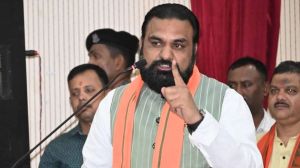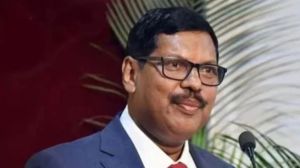Small but powerful
It's early days yet,but it is possible to mark out a distinct feature on the pre-poll landscape.
It’s early days yet,but it is possible to mark out a distinct feature on the pre-poll landscape. Given no clear favourites and a shared sense that the principal players the Congress and BJP will be less decisive to the final outcome this time,the smaller/ regional parties,including those currently within the UPA and NDA,are bolder in their imaginings of themselves as kingmakers,even as kings and queens. At the very least,they perceive a loosening up of space for manoeuvre and elbow room for themselves.
In part,its a carryover from the Lok Sabha results of 2004. After the bewilderment wore off ham nahin jaante ham kyon haare; jo jeete hain woh nahin jaante woh kyon jeete, said Atal Bihari Vajpayee in November 2004 there was no mistaking the political writing on the wall.
• Alliances were key to the result in 2004. For the first time,the Congress plunged into alliance politics and the gambit delivered a Congress victory though its own tally rose to only 145,an improvement of 31 seats over its worst-ever performance in the 1999. It registered a marginal improvement of 1.3 percentage points in the seats it had contested.
But its allies were a different story. Their seats increased from 23 in 1999 to 77 in 2004,their vote share rising from 5.7 per cent to 10.1 per cent. The UPA managed to overtake the NDA in popular vote share largely because its allies brought new support in states like Tamil Nadu,Andhra Pradesh,Bihar,Jharkhand and Maharashtra. The BJP lost allies from 1999 to 2004,a fact that went unnoticed in the India Shining hype.
• The trend that began with the collapse of Congress dominance in 1991 of the emergence of the state as the primary locale of political choice had dug in by the end of the 1990s. The 2004 scorecard underlined it: there was no uniform nationwide swing. If states like Tamil Nadu,West Bengal,and Bihar tilted towards the UPA,the NDA gained votes in states like Rajasthan,Madhya Pradesh,Maharashtra,Punjab and Kerala.
• Given the narrowness of margins in 2004,the arithmetic of alliances and seat-vote disproportionality seemed to explain the outcome more than political issues or policy decisions.
But the character of pre-poll jostling in non-Congress,non-BJP parties before Elections 2009 is also influenced by more recent events. Having debuted as coalition-maker in 2004,the Congress is seen by allies,present and potential,to have backtracked on the alliance question. At the recent CWC meet,it declared it would strike only state-specific alliances with UPA partners; there will be no national-level alliance.
There has also been a significant change in the position and more crucially,the self-image of the Left parties and the BSP between 2004 and 2009. As Prakash Karat explained in Peoples Democracy,in 2004 the primary imperative for Left parties was to defeat communal forces,seen to be on the ascendant after six years of the BJP-led regime. In 2009,the Left has pledged to work for electing a non-UPA and non-NDA alternative. The BSP,riding on its famous victory in the UP Assembly polls in 2007,is the other party staking claim to be the new nucleus of the new regime.
CPI and CPM
In the three states they currently rule,the Left parties do not seriously expect to repeat the results of 2004. But they are counting on alliances they have already stitched up with the AIADMK in Tamil Nadu,JD(S) in Karnataka,the grand alliance with the TDP and TRS in Andhra Pradesh,and with the NCP and AUDF in Assam. The CPI has allied with the NCP in Manipur. Then,there is the friendly association of Left parties with the BSP.
According to sources,the CPI is also talking to other parties,currently allied with the BJP and Congress,to secure their cooperation and participation in the post-poll scenario. It is talking to Naveen Patnaiks BJD,Sharad Pawars NCP,Lalu Yadavs RJD,Paswans LJP and Nitish Kumars JD(U).
Both the CPI and CPI(M) claim the moment is right for the Left to bid for a larger role in the post-poll scenario. According to them,Indias relative equanimity in the face of the global economic downturn is seen to be a direct result of Left pressure on UPA policies; in its four-and-a-half years of rendering outside support to the UPA,the Left has finally shrugged off its reputation of being the naysayer; Assembly election results after 26/11 highlighted not just a downswing in BJP fortunes but also that any votes lost by either of the two main parties will not cross over to each other,but,as in Delhi and Rajasthan,to third parties.
The CPI(M) disclaims any talks with parties still allied with the Congress and BJP. The CPI may be talking to such parties,say CPI(M) sources,because it is driven by different considerations a euphemism for the CPIs heightened search for relevance ever since it came close to losing its national party status.
NCP (partner,UPA)
The NCP,born in 1999 on the plank of opposition to Sonia Gandhis foreign origins,allied with the Congress to form the government in Maharashtra the same year and at the Centre in 2004. It is also in government with the Congress in Goa. Today,it is probably the Congresss most disgruntled ally. The Congress does not understand at the national level the logic,essence and function of a political coalition,says DP Tripathi,general secretary,NCP.
It is not just the CWCs no-national-alliances posturing that bothers the NCP. The Congress did not yield any governors,ambassadors or chairpersons of commissions to the NCP or to any of its allies,for that matter. It did not even consult the NCP in the appointment of the governor in Maharashtra.
NCP sources say there will be relatively few problems in seat-sharing with the Congress in Maharashtra,Goa,Gujarat,and Bihar. Difficulties will arise in states where the NCP believes it has emerged stronger: in Kerala,Orissa,Assam and Meghalaya.
The NCP has the self-image of a small party with a large leader. Sharad Pawars meeting with SP general secretary Amar Singh last week and the NCPs reported overtures to the Left must be viewed in this context.
BJD (partner,NDA)
Two elections in the first week of February,for municipal corporations in Cuttack and Baripada,have confirmed the trend in Orissa: the BJDs electoral fortunes have been rising despite a two-term incumbency,while the BJPs strength is dipping in the state. Both parties,partners in the NDA,form a coalition government at the state level,but fight local body polls separately.
In Cuttack,the BJD won 37 seats and two went to the BJP last time,the BJP had won a majority as well as the post of mayor. Baripada,traditionally a Congress hub that had been wrested by the BJP and JMM,has also swung unambiguously to the BJD. In rural bodies,the BJD has displaced the Congress from number one spot,while the BJP remains at number three.
Today,as the BJD negotiates with the BJP for a seat-sharing arrangement ahead of the Lok Sabha and accompanying assembly polls,the two parties disparate electoral fortunes are a factor.
The BJD also sees itself as the BJPs first major secular ally. Communal tensions worked up by the Parivar,particularly the Bajrang Dal,and especially in Kandhamal,have become part of the BJDs calculus in its pre-poll bargaining with the BJP.
TDP
The TDP is yet to recover from its electoral rout in the Assembly polls of 2004. It is still singed by its open association with the BJP at the Centre,which it believes cost it a large chunk of the 12-13 per cent minority vote in Andhra Pradesh. Gujarat,say sources in the party,was the turning point.
Ahead of the simultaneous Assembly and Lok Sabha polls,the TDP has tied up with the CPI,CPI(M),and TRS in a grand alliance. It hopes the alliance will sweep Telangana,and that outside the region,the newly arisen Chiranjeevi factor will cut into the Congresss votes more than the TDPs.
For the new post-poll alignment at the Centre,the TDP draws one clear line,and another fuzzier one. It cannot ally with the Congress,say sources in the party,given its birth in anti-Congressism. And it cannot be seen to ally with the BJP. In the event of a secular third alternative not gathering enough numbers,therefore,the TDP may fall silent in favour of a BJP-led alliance.



- 01
- 02
- 03
- 04
- 05




























